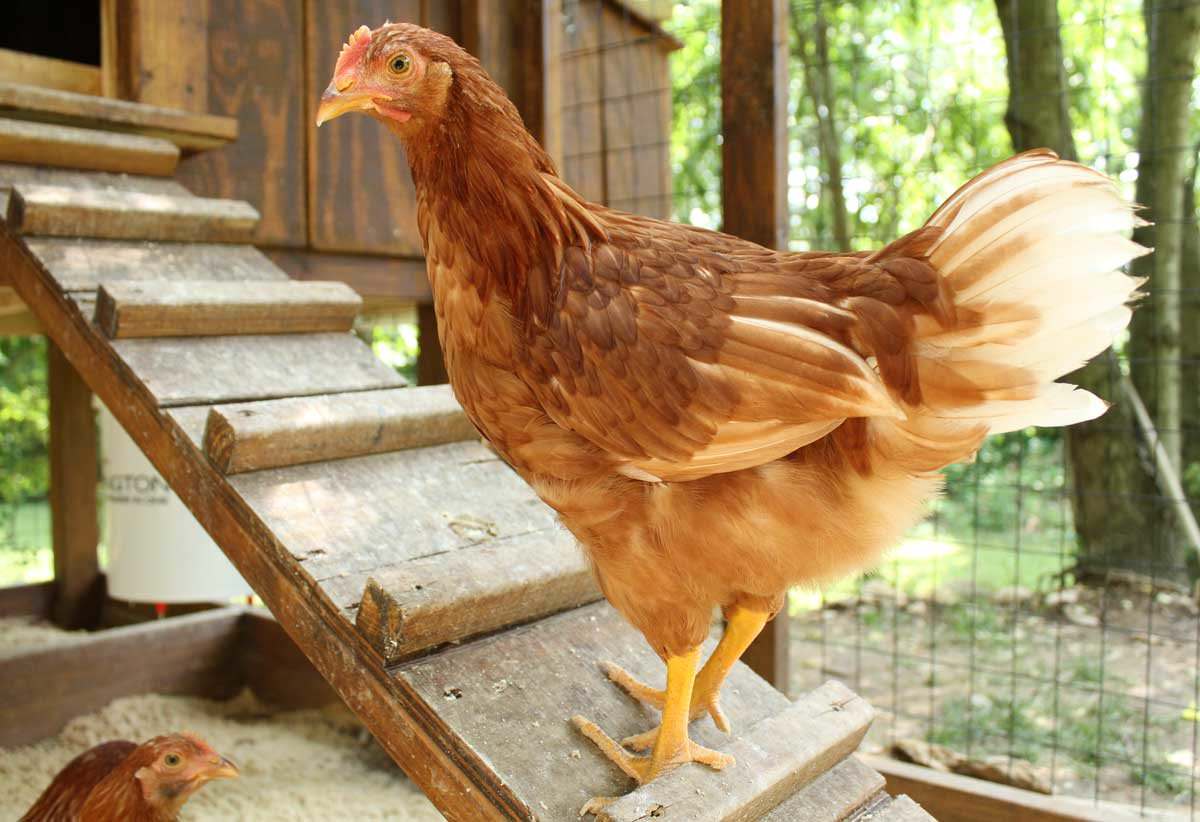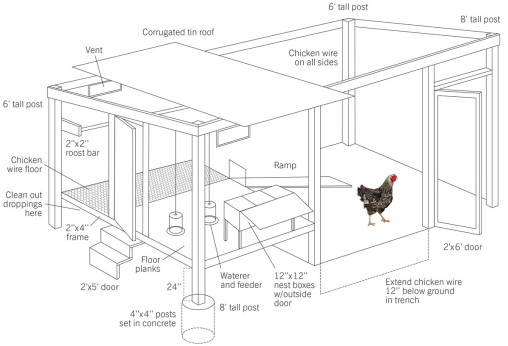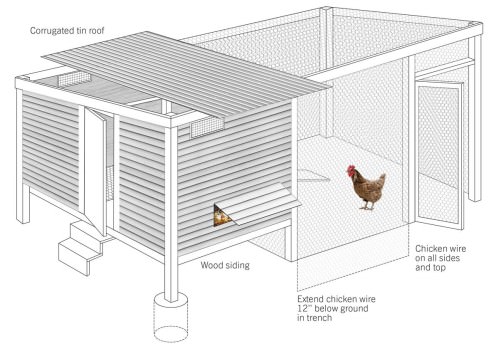How to Build a Chicken Coop
Planning to join the masses of backyard poultry farmers this year? Here’s what you need to know for a top-notch henhouse.
How to Build a Chicken Coop
Planning to join the masses of backyard poultry farmers this year? Here’s what you need to know for a top-notch henhouse.

Building a basic chicken coop for a small flock of birds is a solid weekend project for the determined do-it-yourselfer with basic carpentry skills, while the more elaborate coops could easily take several weeks (and will require advanced carpentry skills).
The internet is awash in plans for backyard chicken coops, which are a great place to look for inspiration, but all coops have two main components: an enclosed space for sleeping and laying eggs and an open air ‘chicken run’ to roam around in during the day. The enclosed space should open directly to the run, but should be elevated at least two feet above it so there is space to collect the droppings that fall through the floor. (More on that in a moment.) There are many possible ways to configure a coop, but here’s how to build a basic model that can easily be customized according to your aesthetic tastes.
Step 1: Plan for Size and Location
The first thing to consider is size. The accepted minimum sizes are 2 to 3 square feet per bird inside the coop and 4 to 5 square feet per bird in the run. However, extra space is always better – just like humans, chickens are prone to squabbling when they’re packed in tight quarters at all times.
Chickens need shade in the heat of the day, so locating the coop under a large deciduous tree is ideal – they will be cool in summer and can bask in the sun during winter once the leaves have dropped. If a site under a large tree is not available, you’ll have to shade the run with shade cloth.
Step 2: Build the Frame
As with most outbuildings, the simplest approach is to begin with a rectangular frame and then add on the various components that are needed. Use naturally rot-resistant lumber – such as cedar or redwood – rather than pressure treated lumber which contains heavy metals, like arsenic, that may be harmful to your chicken’s health. The open-air run should be covered with chicken wire (metal mesh) on all sides to prevent predators from entering.

Step 3: Outfit the Interior
The interior of the run needs nothing more than a thick layer of straw over the ground to absorb chicken droppings and moisture when it rains. A watering device may also be hung from one of the rafters (by bailing wire attached to a nail) so the birds can drink when they’re outside during the day. (The base of the waterer should be 6 to 8 inches above ground level.) If the run does not receive shade during the hottest hours of the day, add a layer of shade cloth on top of the chicken wire ceiling. Build a gently sloping ramp at least 8 inches wide from the ground level up to the platform for the enclosed area. Before this area is enclosed, outfit it with the following items:
Locate the nest boxes along the front wall at least 24 inches above the floor. These can be as simple as wooden shelves with plywood dividers that are filled with straw. Add a 2-inch piece of wood across the front of the boxes to keep the straw from spilling out. There are also prefabricated nest boxes available, though some chicken keepers use plastic kitty litter boxes for nests because they are easy to remove and clean periodically. The roosts should be positioned higher than the nests. Chickens are descended from tree-dwelling jungle fowl and will always seek out the highest point to sleep (and the nests will quickly become soiled if the chickens use them for roosting).
Step 4: Finish the Exterior
Now is the time to add a roof and walls to enclose the nesting and roosting area. Any weatherproof material may be used, but tin is an easy, yet fashionable, choice for the roof, and wood siding makes a quaint exterior for the walls. (Additional 2Á—4 framing will be necessary for the walls and roof structure.) When you build the walls, make sure to plan for easy access to collect eggs and clean the coop. All access points should be lockable with raccoon-proof latches – a typical gate latch with a carabiner in the turnbuckle is usually sufficient to foil these masked bandits.
Plan for access on three sides:
The three types of access doors may be constructed with a simple 2Á—2 frame in the same fashion as the main entry gate to the chicken run. Instead of covering them with chicken wire, use the same material that was used for the exterior of the coop. (No anti-sag kit will be needed in this case.)
Ventilation is extremely important in summer. The chicken door and the portion of the floor covered with wire mesh will allow air in from below, but there are also needs to be a place for hot air to exit at the top. Either leave space between the eaves of the roof and the top of the walls or cut vents near the top of the walls. In either case, makes sure these spaces are covered with chicken wire to keep critters out.

These are the basics of a functional coop, but feel free to customize it and glorify it any way you like. Ornate trimwork, gaudy knick-knacks, and colorful artwork are all par for the course in the world chicken coop décor.
Follow us

This work is licensed under a Creative Commons Attribution-NoDerivatives 4.0 International License.
Want to republish a Modern Farmer story?
We are happy for Modern Farmer stories to be shared, and encourage you to republish our articles for your audience. When doing so, we ask that you follow these guidelines:
Please credit us and our writers
For the author byline, please use “Author Name, Modern Farmer.” At the top of our stories, if on the web, please include this text and link: “This story was originally published by Modern Farmer.”
Please make sure to include a link back to either our home page or the article URL.
At the bottom of the story, please include the following text:
“Modern Farmer is a nonprofit initiative dedicated to raising awareness and catalyzing action at the intersection of food, agriculture, and society. Read more at <link>Modern Farmer</link>.”
Use our widget
We’d like to be able to track our stories, so we ask that if you republish our content, you do so using our widget (located on the left hand side of the article). The HTML code has a built-in tracker that tells us the data and domain where the story was published, as well as view counts.
Check the image requirements
It’s your responsibility to confirm you're licensed to republish images in our articles. Some images, such as those from commercial providers, don't allow their images to be republished without permission or payment. Copyright terms are generally listed in the image caption and attribution. You are welcome to omit our images or substitute with your own. Charts and interactive graphics follow the same rules.
Don’t change too much. Or, ask us first.
Articles must be republished in their entirety. It’s okay to change references to time (“today” to “yesterday”) or location (“Iowa City, IA” to “here”). But please keep everything else the same.
If you feel strongly that a more material edit needs to be made, get in touch with us at [email protected]. We’re happy to discuss it with the original author, but we must have prior approval for changes before publication.
Special cases
Extracts. You may run the first few lines or paragraphs of the article and then say: “Read the full article at Modern Farmer” with a link back to the original article.
Quotes. You may quote authors provided you include a link back to the article URL.
Translations. These require writer approval. To inquire about translation of a Modern Farmer article, contact us at [email protected]
Signed consent / copyright release forms. These are not required, provided you are following these guidelines.
Print. Articles can be republished in print under these same rules, with the exception that you do not need to include the links.
Tag us
When sharing the story on social media, please tag us using the following: - Twitter (@ModFarm) - Facebook (@ModernFarmerMedia) - Instagram (@modfarm)
Use our content respectfully
Modern Farmer is a nonprofit and as such we share our content for free and in good faith in order to reach new audiences. Respectfully,
No selling ads against our stories. It’s okay to put our stories on pages with ads.
Don’t republish our material wholesale, or automatically; you need to select stories to be republished individually.
You have no rights to sell, license, syndicate, or otherwise represent yourself as the authorized owner of our material to any third parties. This means that you cannot actively publish or submit our work for syndication to third party platforms or apps like Apple News or Google News. We understand that publishers cannot fully control when certain third parties automatically summarize or crawl content from publishers’ own sites.
Keep in touch
We want to hear from you if you love Modern Farmer content, have a collaboration idea, or anything else to share. As a nonprofit outlet, we work in service of our community and are always open to comments, feedback, and ideas. Contact us at [email protected].by Brian Barth, Modern Farmer
September 8, 2015
Modern Farmer Weekly
Solutions Hub
Innovations, ideas and inspiration. Actionable solutions for a resilient food system.
ExploreExplore other topics
Share With Us
We want to hear from Modern Farmer readers who have thoughtful commentary, actionable solutions, or helpful ideas to share.
SubmitNecessary cookies are absolutely essential for the website to function properly. This category only includes cookies that ensures basic functionalities and security features of the website. These cookies do not store any personal information.
Any cookies that may not be particularly necessary for the website to function and are used specifically to collect user personal data via analytics, ads, other embedded contents are termed as non-necessary cookies.
Can I get the plans?
Very helpful info. Am staring this weekend.
Can I get a printout of these plans ? Thank You
Hi,
I’m a little concerned about the corrugated roof. I have worked in a corrugated shed and when it rained the noise was deafening, also there is likely to be condensation on the inside and it provides zero hat insulation.
My hen huts have ply roof with felt.
Cheers
Michael
There are many advantages to owning your own chickens. Farm fresh eggs are healthier, tastier, and readily available from your own back yard. Meat birds are fast growing, take little space to raise and are fairly inexpensive for the resulting outcome in food production. Raising your own chickens means you get to decide what goes into the making of the final product. I personally build a great chicken coop following this easy and step by step guide I found HERE: ( http://easy-chicken-coop.trusted-source.info )
Send plans
Thanks for the information.
it will be very helpful
Is it possible to get a copy of the plans?
I find this information very useful, am planning to start poultry farm in at home.
Thanks for your support.
Samuel
Uganda Kampala
it really looks amazing and inspiring, the structures. I like it to build for my chicken very helpful. think you
miles kennedy macloudy
zambia